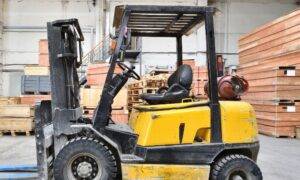What Are the Different Types of Forklifts?
Forklifts are essential machines in various industries, from warehouses to construction sites. They play a crucial role in moving heavy loads efficiently and improving employee efficiency and team-member safety. Knowing the different types of forklifts available and their specific uses for small business owners, warehouse managers, and more is important.
Counterbalance Forklifts
Counterbalance forklifts are the most common and versatile type. These forklifts have a weight in the rear to counterbalance the load at the front, making them ideal for lifting and moving heavy materials. You’ll find them in warehouses, manufacturing plants, and distribution centers. Their straightforward design makes them easy to operate and offers excellent stability and maneuverability.
Reach Forklifts
 Reach forklifts are best for high-reaching tasks. They have extended lift heights and are perfect for stacking pallets in high racks. Warehouses with narrow aisles and high storage systems commonly use these forklifts. Their ability to reach great heights without losing stability makes them invaluable for maximizing storage space.
Reach forklifts are best for high-reaching tasks. They have extended lift heights and are perfect for stacking pallets in high racks. Warehouses with narrow aisles and high storage systems commonly use these forklifts. Their ability to reach great heights without losing stability makes them invaluable for maximizing storage space.
Rough-Terrain Forklifts
Rough terrain forklifts can handle outdoor use and uneven surfaces with ease. They have large, sturdy tires and powerful engines to tackle challenging environments. They’re also known as all-terrain forklifts.
Whether you’re on a construction site or a lumberyard, these forklifts ensure that you can move materials safely and efficiently, no matter the terrain. The all-terrain forklift benefits include improved stability and traction, making them indispensable for outdoor projects.
Sideloader Forklifts
Sideloader forklifts can handle long loads, such as pipes, lumber, or steel beams. They have a unique configuration where the operator sits sideways, allowing the forklift to pick up loads from the side. This design is perfect for navigating narrow aisles and confined spaces. Side loaders commonly appear in timber yards, steel factories, and warehouses that store bulky items.
Telescopic Handler Forklifts
Telescopic handler forklifts, also known as telehandlers, are versatile machines often seen in construction. They feature an extendable boom that allows them to reach high and far. Telescopic handlers can lift heavy loads to great heights and are perfect for placing materials on rooftops or scaffolding. Their adaptability makes them a favorite in construction projects where flexibility and reach are essential.
Electric Forklifts
Electric forklifts are eco-friendly alternatives to traditional fuel-powered models. They run on rechargeable batteries and produce zero emissions, making them ideal for indoor use. Electric forklifts are quiet, reducing noise pollution in the workplace. They’re perfect for warehouses, food processing plants, and any environment where air quality is a concern. Plus, they have lower operating costs compared to their fuel-powered counterparts.
Understanding the different types of forklifts and their applications can significantly improve employee efficiency and safety in your workplace. Choose the right forklift based on your specific needs, and you’ll see a productivity and operational efficiency boost.



5 Comments
Terri Quick
Interesting…I didn’t know that there are different types
heather
I had no idea that there were so many different kinds of forklifts. I would love to learn how to drive one of these looks fun.
Tamra Phelps
I had no idea there were different types of forklifts. Interesting. There’s one for every possible scenario.
gloria patterson
Weird I typed something and the ghost got it.
30 + years ago I worked (office) at a mfg company. My office was in the plastic plant
Some of the guys taught meto drive a reach forklift. I was able to move a skid around but NEVER brave enough to take one off the shelf
gloria patterson
That is a lot of different fork lifts. a company (office work) I worked for 30+ years ago was the shipping area of our plastic plant. Several of the guys taught me how to drive a reach forklift. I was brave enough to move the skid around the building but never brave enough to reach up and take a skid off a shelf.